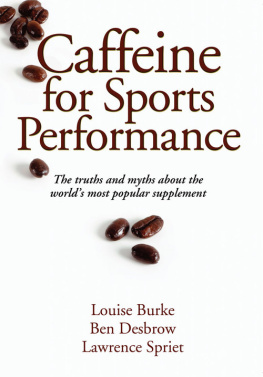LITTLE, BROWN
First published in Great Britain in 2018 by Little, Brown
Copyright Joo Medeiros 2018
The moral right of the author has been asserted.
All rights reserved.
No part of this publication may be reproduced, stored in a retrieval system, or transmitted, in any form or by any means, without the prior permission in writing of the publisher, nor be otherwise circulated in any form of binding or cover other than that in which it is published and without a similar condition including this condition being imposed on the subsequent purchaser.
A CIP catalogue record for this book
is available from the British Library.
ISBN 978-1-4087-0847-7
Little, Brown
An imprint of
Little, Brown Book Group
Carmelite House
50 Victoria Embankment
London EC4Y 0DZ
An Hachette UK Company
www.hachette.co.uk
www.littlebrown.co.uk
TO MY PARENTS
CONTENTS
I n 2012, I became obsessed with a story that mixed science and sport, about a community of researchers, coaches and analysts who, for the past twenty years or so, have pioneered new ways of addressing the most fundamental question in sport: what does it take to win?
It all began with a casual observation. At the London Olympics, I found myself wondering how on earth the British Olympic Team had come to be so good. After all, at the 1996 Games in Atlanta, Great Britain had ranked only thirty-sixth in the medal table, finishing below countries like Algeria, Belgium and Kazakhstan. That was their worst-ever result, a dismal performance labelled a national scandal by the British press.
The government was compelled to intervene. Money was promised; a dedicated agency, UK Sport, was set up to distribute the funds, a vast proportion of which were sourced from National Lottery revenue. The criteria for the allocation of funds were strict. The money could not be used to increase grassroots participation or even to simply improve the performance of athletes. Instead, it had to be used to target a specific number of world titles and Olympic gold medals. This policy became known as the no-compromise system, with targeted investment in the sports with the best chances of winning medals.
In other words, UK Sport invested in success. And at the following three Olympics Sydney, Athens and Beijing Team GB steadily rose through the ranks.
For the London Games, approximately half a billion pounds was spent over the four-year Olympic cycle. This was still significantly less than the amounts spent by countries like South Korea and Japan, and only a blip when compared to the billions invested by the sporting superpowers of Russia, China and the USA.
With the National Lottery money, national sporting centres were built and athletes were able to train full time. This funding also supported, in 2002, the launch of UK Sports technology, science and medicine arm, the English Institute of Sport. At the core of the EISs mission was the provision of sports scientists to all of the national sports teams. The EIS was modelled on the Australian Institute of Sport, which, at the turn of the millennium, had been seen as the best in the world for sports science. By 2012, it was clear that the EIS was now the model to emulate.
So how did a sporting nation reinvent itself so completely in less than a generation?
That was the question I asked Peter Keen, the performance director of UK Sport.
Im surprised very few people have asked that question before, he answered. When I have spoken about this, I come across as clinical and cold and that clashes with peoples view of sport as something poetic, but I will give you a blunt and conclusive answer. He stood in silence for a few moments. What has happened in the past twenty years is that weve engaged with performance in a rational, scientific way. To apply the scientific method, you need data and you need the ability to set hypotheses and examine them in the simplest terms. Part of this formula of success is the ability to be objective. That level of objectivity, when harnessed, is very powerful.
After London 2012, UK Sport made two major announcements. The first, made publicly in December 2013, was Britains goal to take home sixty-six medals at the 2016 Rio Olympic Games, which would make them the first host nation to deliver more medals at the following Games.
The second was made internally, to all coaches, directors and sports scientists. A performance-planning process, What it Takes to Win, was to be rolled out across the British high-performance system.
As I immersed myself in the world of elite performance and met some of the sports scientists behind the scenes the team behind the team I became invested in their four-year journey leading up to Rio.
During those four years, the phrase What it Takes to Win gradually gained traction among coaches and scientists, an expression of a common philosophy. The concepts that underpinned this approach, however, were far from new.
It all started, in a sense, as a grand experiment: to rethink how sport is played, how it is performed, how people train and how people coach. This experiment had its origins at Liverpool Polytechnic (now Liverpool John Moores University), home to the worlds first sports science faculty. It was there, in the late eighties, that a motley group a mathematician, a physiologist, a psychologist and a former basketball player pioneered the means to analyse performance. To do so, they hung around at courts and in changing rooms, made a nuisance of themselves in clubhouses, and hauled computers to football pitches. They closely studied elite coaches, proving that even the very best among them could not accurately recollect the most crucial events in a match; they conducted studies which for the first time quantified the physiological effort made by football players; and they wrote software that could predict the winners of squash tournaments.
This novel approach to performance underwent its first mutation in the early days of the English Institute of Sport, when many of the same sports scientists who had pioneered these methods in an academic environment were embedded directly within national teams. Now, their primary job was not to further science, but to help to win gold medals. At various locations, under similar circumstances, the first successful iterations of this model emerged: in squash, in rugby, in cycling and in Formula One.
As the UK high-performance system geared up for London 2012, these methods of achieving success became widespread, and the results were soon made clear to the world. Then, in 2016, at the Rio Games, Britain made history by not only winning two more medals than the sixty-five that they had at London 2012, but also clinching second place in the medal table, above China.
The real success was, of course, down to talented and dedicated individuals. Behind each medal was a closely bound triumvirate: a talented athlete, an astute coach and a methodical sports scientist. And theirs was invariably a story of struggle, guesswork, dedication and conflict.
It is true of any story about competition and sports. But this book leans towards the least well-known element in that equation: the sports scientist.
Sports scientists are the people behind many successful teams winners of European football championships, rugby world champions, and Olympic gold medallists. They have helped teams disrupt their way out of an endless loop of defeat and ensure that winners retain their competitive edge. These are the people who, through a trial-and-error approach to the scientific method, have sought to address the most fundamental question in sport: what does it take to win?










